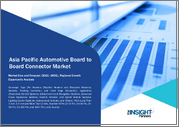
|
시장보고서
상품코드
1734900
세계의 자동차 리스토어 시장 예측(-2032년) : 리스토어 유형별, 차량 유형별, 리스토어 스타일별, 고객 유형별, 서비스 채널별, 리스토어 목적별, 용도별, 지역별 분석Automotive Restoration Market Forecasts to 2032 - Global Analysis By Restoration Type, Vehicle Type, Restoration Style, Customer Type, Service Channel, Restoration Purpose, Application and By Geography |
||||||
Stratistics MRC에 따르면 세계의 자동차 리스토어 시장은 2025년에 33억 4,000만 달러를 차지하고 예측 기간 동안 13.2%의 연평균 복합 성장률(CAGR)로 성장하여 2032년까지는 79억 5,000만 달러에 이를 것으로 예측되고 있습니다.
빈티지 자동차와 클래식 자동차를 원래의 상태, 때로는 새로운 차량 이상으로 복구하는 과정은 자동차 복원으로 알려져 있습니다. 전문가도 애호가도, 클래식 카의 리스토어를 즐기고, 장인기술을 사랑해, 역사를 지키기 위해서 리스토어에 임하고 있습니다. 또한, 자동차의 리스토어는 자신의 프라이드를 위해서든, 전매 가치를 위해서든, 오토쇼 참가를 위해서라도, 이전의 시대의 유산과 기술력에 경의를 표하는 것입니다.
호주 모터 헤리티지 재단(AMHF)에 따르면, 호주인은 클래식 카의 구입비를 제외하고, 연간 100억 달러 가까이를 클래식 카에 지출하고 있습니다.
빈티지, 클래식 자동차에 대한 관심 증가
클래식 자동차, 빈티지 자동차, 골동품 자동차는 투자 자산과 문화재로 점점 인기가 높아지고 있습니다. 이러한 수요로 인해 이러한 자동차를 쇼룸과 콩쿨 상태로 되돌리는 리스토어 서비스의 건전한 시장이 존재합니다.
전문 장인에 대한 액세스가 제한되어 있습니다.
빈티지 의자, 엔진 재생, 금속 가공, 클래식 전기 시스템은 실제 자동차 복원에 필요한 전문 기술 중 일부에 불과하며 이러한 능력은 점점 희귀 해지고 있습니다. 이 분야에 참가하는 것이 적기 때문에 수리업계는 스킬 갭에 직면하고 있습니다.
수리 교육 및 교육 이니셔티브 성장
업계는 스킬 갭을 경험하고 있기 때문에 자동차 리스토어의 직업 훈련과 인정 프로그램을 작성해 성장시킬 명확한 기회가 있습니다. 차세대를 담당하는 수리가를 육성하는 한편, 관민 파트너십은 전통 기술의 보존에도 도움이 됩니다. 또한, 인재 개발 투자를 실시하는 기업은 장기적인 사업 연속성을 확보해, 경쟁상의 우위성을 얻을 수 있습니다.
인건비와 재료비 증가
세계 인플레이션, 공급망 혼란, 노동력 부족으로 고품질 수리에 필요한 재료(금속, 고무, 도료 등)와 숙련 노동자의 비용이 상승하고 있습니다. 소규모 상점에서는 이러한 비용을 충당하거나 고객에게 전가하기가 더 어려워질 수 있습니다.
COVID-19의 영향:
COVID-19의 유행은 자동차 리스토어 시장에 다양한 영향을 주었습니다. 한편, 빈티지 부품 조달 지연, 재료비 상승, 잠금 및 안전 프로토콜로 인해 워크숍 조업이 제한되는 등 세계 공급망의 혼란의 결과로 프로젝트가 지연되거나 취소되었습니다. 소비자층이 집에서 보내는 시간을 늘려, 보다 많은 돈을 사용할 수 있게 되었기 때문에 빈티지 카의 리스토어 등, 취미인에 의한 개인적인 프로젝트에 대한 관심이 다시 높아졌습니다.
예측 기간 동안 완전/완벽 리스토어 부서가 최대가 될 전망
완전/완벽 리스토어 부문은 예측 기간 동안 가장 큰 시장 점유율을 차지할 것으로 예측됩니다. 완벽 리스토어가 애호가, 컬렉터, 투자자에게 선호되는 것은 특히 희귀 모델이나 빈티지 모델의 경우, 그 모델 시장 가치와 미적 매력을 대폭 높여주기 때문입니다.
고급차 리스토어 분야는 예측기간 중 가장 높은 CAGR이 예상된다.
예측기간 중, 고급차의 수복 분야가 가장 높은 성장률을 나타낼 것으로 예측됩니다. 부유한 투자자나 컬렉터는 희귀한 고급 모델의 보존이나 개량에 다액의 자금을 투입할 준비가 있습니다.
최대 점유율을 차지하는 지역:
예측 기간 동안 북미가 가장 큰 시장 점유율을 차지할 것으로 예측됩니다. 이는 자동차 애프터마켓 산업이 번성하고 클래식 자동차 애호가의 인구가 많고 자동차의 리스토어 문화가 뿌리 내리고 있기 때문입니다. 리스토어 숍, 전문 부품 공급업체의 광범위한 네트워크, 빈티지 자동차 및 클래식 자동차 리스토어에 투자하는 데 관심이 많은 소비자층을 보유한 미국은 특히 시장을 선도하고 있습니다. 또한, 빈티지 자동차 쇼와 경매의 매력이 높아지고, 뛰어난 리스토어 서비스에 대한 요구가 높아지고 있는 것도, 이 시장에서의 북미의 지배적 지위를 보다 견고하게 하고 있습니다.
CAGR이 가장 높은 지역:
예측 기간 동안 아시아태평양이 가장 높은 CAGR을 나타낼 것으로 예측됩니다. 이 증가의 주요 원인은 클래식 자동차와 빈티지 자동차에 대한 수요 증가, 가처분 소득 증가, 한국, 중국, 일본, 인도 등 국가의 애호가 증가입니다. 특히, 전문적인 리스토어 서비스를 이용할 수 있는 것, 자동차의 유산을 보존하는 것에 대한 관심이 높아지고 있기 때문에 인도의 자동차 리스토어 시장은 9.8%라는 경이적인 성장률이 될 것으로 예측됩니다. 게다가 동남아시아에서는 9.0%의 성장이 예측되고 있으며, 이는 경제 확대나 문화적 평가에 뒷받침된 클래식 카의 복구를 위한 지역적 동향을 반영하고 있습니다.
무료 주문을 받아서 만드는 서비스:
이 보고서를 구독하는 고객은 다음 무료 맞춤설정 옵션 중 하나를 사용할 수 있습니다.
- 기업 프로파일
- 추가 시장 기업의 종합적 프로파일링(3개사까지)
- 주요 기업의 SWOT 분석(3개사까지)
- 지역 세분화
- 고객의 관심에 응한 주요국 시장 추계, 예측, CAGR(주: 타당성 확인에 따름)
- 경쟁 벤치마킹
- 제품 포트폴리오, 지리적 존재, 전략적 제휴에 기반한 주요 기업 벤치마킹
목차
제1장 주요 요약
제2장 서문
- 개요
- 이해관계자
- 조사 범위
- 조사 방법
- 데이터 마이닝
- 데이터 분석
- 데이터 검증
- 조사 접근
- 조사 정보원
- 1차 조사 정보원
- 2차 조사 정보원
- 전제조건
제3장 시장 동향 분석
- 성장 촉진요인
- 억제요인
- 기회
- 위협
- 용도 분석
- 신흥 시장
- COVID-19의 영향
제4장 Porter's Five Forces 분석
- 공급기업의 협상력
- 구매자의 협상력
- 대체품의 위협
- 신규 참가업체의 위협
- 경쟁 기업간 경쟁 관계
제5장 세계의 자동차 리스토어 시장 : 리스토어 유형별
- 차체 리스토어
- 기계 리스토어
- 인테리어 리스토어
- 부분 리스토어
- 완전 리스토어
제6장 세계의 자동차 리스토어 시장 : 차량 유형별
- 클래식 자동차
- 머슬 자동차
- 빈티지 자동차
- 모던 클래식
제7장 세계의 자동차 리스토어 시장 : 리스토어 스타일별
- 콩쿨 수리
- 드라이버 수리
- 리스토 모드
- 보존
제8장 세계 자동차 리스토어 시장 : 고객 유형별
- 개인 소유자
- 수집가
- 박물관
- 딜러
제9장 세계의 자동차 리스토어 시장 : 서비스 채널별
- 인증 수리 센터
- 독립 워크숍
- OEM 수리 프로그램
제10장 세계의 자동차 리스토어 시장 : 리스토어 목적별
- 투자
- 취미
- 컬렉션
- 쇼커
제11장 세계의 자동차 리스토어 시장 : 용도별
- 클래식 자동차 수리
- 머슬 자동차 수리
- 골동품 자동차 수리
- 고급차 수복
제12장 세계의 자동차 리스토어 시장 : 지역별
- 북미
- 미국
- 캐나다
- 멕시코
- 유럽
- 독일
- 영국
- 이탈리아
- 프랑스
- 스페인
- 기타 유럽
- 아시아태평양
- 일본
- 중국
- 인도
- 호주
- 뉴질랜드
- 한국
- 기타 아시아태평양
- 남미
- 아르헨티나
- 브라질
- 칠레
- 기타 남미
- 중동 및 아프리카
- 사우디아라비아
- 아랍에미리트(UAE)
- 카타르
- 남아프리카
- 기타 중동 및 아프리카
제13장 주요 발전
- 계약, 파트너십, 협업, 합작투자
- 인수합병
- 신제품 발매
- 사업 확대
- 기타 주요 전략
제14장 기업 프로파일링
- Carrozzeria Touring Superleggera Srl
- Armadillo Auto Restoration Inc
- Speedway Motors, Inc
- Klassik Car SA
- Year One, Inc.
- Classic Industries
- Carrosserie Lecoq
- Velocity Restorations Inc
- Burlen LTD
- European Collectibles
- Singer Vehicle Design
- Muscle Car Restorations Inc.
- Emory Motorsports Inc
- Canepa Inc
- Bell Sport & Classic
According to Stratistics MRC, the Global Automotive Restoration Market is accounted for $3.34 billion in 2025 and is expected to reach $7.95 billion by 2032 growing at a CAGR of 13.2% during the forecast period. The process of restoring a vintage or classic car to its original state-or occasionally even better than new-is known as automotive restoration. Disassembling the vehicle, fixing or replacing damaged components, restoring the body and paint job, and updating the interior to original standards are all part of this painstaking process. Both experts and enthusiasts work on restorations for the enjoyment of restoring classic cars, the love of craftsmanship, and the preservation of history. Moreover, automotive restoration honors the legacy and technical prowess of earlier times, whether for one's own pride, resale value, or participation in auto shows.
According to the Australian Motor Heritage Foundation (AMHF), Australians spend nearly $10 billion annually on classic vehicles, excluding the cost of purchasing the cars. An economic survey by the AMHF revealed that car enthusiasts spend about $10,240 per vehicle each year on maintenance, restoration, and running costs.
Market Dynamics:
Driver:
Growing interest in vintage and classic automobiles
Classic, vintage, and antique cars are becoming more and more popular as investment assets and cultural artifacts. Due to their distinctive designs, straightforward mechanics, and sentimental appeal, enthusiasts frequently seek out rare models from the 1950s to the 1980s. Due to this demand, there is a healthy market for restoration services that can return these cars to showroom or concours condition. Additionally, owners frequently make large investments in authentic restorations due to the emotional connection and scarcity of these models.
Restraint:
Limited access to expert craftspeople
Vintage upholstery, engine rebuilding, metalworking, and classic electrical systems are just a few of the specialized skills needed for authentic automotive restoration, and these abilities are becoming more and more scarce. Furthermore, the restoration industry is facing a skills gap as more seasoned restorers retire and fewer young technicians join the field. When this shortage is handled by less experienced people, it leads to longer project lead times, increased labor costs, and sometimes poor restorations.
Opportunity:
Growth in restoration training and education initiatives
The industry is experiencing a skills gap, so there is a clear opportunity to create and grow automotive restoration vocational training and certification programs. There are specialized courses available in bodywork, upholstery, paint restoration, and vintage mechanics at institutions and technical schools. While training the upcoming generation of restorers, public-private partnerships can also aid in the preservation of heritage skills. Moreover, businesses that make talent development investments may secure long-term business viability and obtain a competitive advantage.
Threat:
Increasing labor and material costs
The cost of materials (such as metals, rubber, and paint) and skilled labor needed for high-quality restorations has increased due to global inflation, supply chain disruptions, and labor shortages. Restoration projects become less profitable and accessible as a result. When restoration budgets are set, smaller stores might find it difficult to cover these expenses or pass them on to clients. Additionally, the survival of many restoration businesses, especially those with narrow profit margins, is threatened by the ongoing volatility in talent availability and material prices.
Covid-19 Impact:
The COVID-19 pandemic affected the market for auto restoration in a variety of ways. Projects were slowed down or cancelled as a result of global supply chain disruptions that, on the one hand, caused delays in sourcing vintage parts, increased material costs, and restricted workshop operations due to lockdowns and safety protocols. However, as some consumer segments spent more time at home and had more money to spend, there was a renewed interest in personal projects by hobbyists, such as restoring vintage cars. Digital car communities and online auctions also became popular, which helped maintain market participation during restrictions.
The full/complete restoration segment is expected to be the largest during the forecast period
The full/complete restoration segment is expected to account for the largest market share during the forecast period. This section entails overhauling every part of a car, including the bodywork, mechanical systems, interior fittings, and occasionally even small cosmetic details, in order to return it to its original or nearly new state. Complete restorations are preferred by enthusiasts, collectors, and investors because they greatly increase the models' market value and aesthetic appeal, particularly for rare or vintage models. Moreover, the need for thorough restoration is only increasing due to growing interest in historical preservation and classic car auctions.
The luxury car restoration segment is expected to have the highest CAGR during the forecast period
Over the forecast period, the luxury car restoration segment is predicted to witness the highest growth rate. Global wealth is rising, people are becoming more appreciative of luxury brands like Rolls-Royce, Bentley, and Mercedes-Benz, and there is a growing need for individualized restoration that combines classic style with contemporary functionality. Wealthy investors and collectors are prepared to shell out a lot of money to preserve or improve rare luxury models; they frequently commission complete restorations or unique restomods that preserve authenticity while improving drive ability.
Region with largest share:
During the forecast period, the North American region is expected to hold the largest market share, driven by a thriving automotive aftermarket industry, a sizable population of classic car enthusiasts, and a strong culture of vehicle restoration. With its extensive network of restoration shops, specialized parts suppliers, and a sizable consumer base interested in investing in the restoration of vintage and classic cars, the United States in particular leads the market. Additionally, North America's dominant position in this market is further cemented by the rising appeal of vintage car shows and auctions as well as the rising need for superior restoration services.
Region with highest CAGR:
Over the forecast period, the Asia Pacific region is anticipated to exhibit the highest CAGR. The main causes of this increase are the growing demand for classic and vintage cars, rising disposable incomes, and an increase in the number of enthusiasts in nations like South Korea, China, Japan, and India. Specifically, the availability of specialized restoration services and growing interest in conserving automotive heritage are expected to propel India's automotive restoration market to an impressive 9.8% growth rate. Furthermore, a growth of 9.0% is projected for Southeast Asia, which reflects a regional trend toward the restoration of classic cars driven by economic expansion and cultural appreciation.
Key players in the market
Some of the key players in Automotive Restoration Market include Carrozzeria Touring Superleggera S.r.l., Armadillo Auto Restoration Inc, Speedway Motors, Inc, Klassik Car S.A., Year One, Inc., Classic Industries, Carrosserie Lecoq, Velocity Restorations Inc, Burlen LTD, European Collectibles, Singer Vehicle Design, Muscle Car Restorations Inc., Emory Motorsports Inc, Canepa Inc and Bell Sport & Classic.
Key Developments:
In November 2024, Singer - luxury specialists in reimagining the Porsche 911 - will partner with Seven Car Lounge to support clients commissioning restorations in the Middle East. The announcement was made at a special event in Riyadh, Saudi Arabia.
In April 2023, Bell Sport & Classic is taking on the Morgan franchise in Hertfordshire, UK. Based at Bell Sport & Classic's showroom facility in Markyate, Hertfordshire, Morgan Hertfordshire will offer sales and aftersales services for all Morgan models. The company is a specialist in restoration, sales and servicing of collectible cars with a focus on Ferrari.
In May 2020, Salisbury-based Burlen Ltd has acquired the Austin J40 pedal car spares business from long-term owner Roy Halford. The company can now supply a range of J40 pedal car parts and spares, manufactured in-house using traditional and modern manufacturing methods and parts will be immediately available from stock.
Restoration Types Covered:
- Body Restoration
- Mechanical Restoration
- Interior Restoration
- Partial Restoration
- Full/Complete Restoration
Vehicle Types Covered:
- Classic Cars
- Muscle Cars
- Vintage Cars
- Modern Classics
Restoration Styles Covered:
- Concours Restoration
- Driver Restoration
- Resto-Mod
- Preservation
Customer Types Covered:
- Individual Owners
- Collectors
- Museums
- Dealerships
Service Channels Covered:
- Authorized Restoration Centers
- Independent Workshops
- OEM Restoration Programs
Restoration Purposes Covered:
- Investment
- Hobby
- Collection
- Show Car
Applications Covered:
- Classic Car Restoration
- Muscle Car Restoration
- Antique Car Restoration
- Luxury Car Restoration
Regions Covered:
- North America
- US
- Canada
- Mexico
- Europe
- Germany
- UK
- Italy
- France
- Spain
- Rest of Europe
- Asia Pacific
- Japan
- China
- India
- Australia
- New Zealand
- South Korea
- Rest of Asia Pacific
- South America
- Argentina
- Brazil
- Chile
- Rest of South America
- Middle East & Africa
- Saudi Arabia
- UAE
- Qatar
- South Africa
- Rest of Middle East & Africa
What our report offers:
- Market share assessments for the regional and country-level segments
- Strategic recommendations for the new entrants
- Covers Market data for the years 2024, 2025, 2026, 2028, and 2032
- Market Trends (Drivers, Constraints, Opportunities, Threats, Challenges, Investment Opportunities, and recommendations)
- Strategic recommendations in key business segments based on the market estimations
- Competitive landscaping mapping the key common trends
- Company profiling with detailed strategies, financials, and recent developments
- Supply chain trends mapping the latest technological advancements
Free Customization Offerings:
All the customers of this report will be entitled to receive one of the following free customization options:
- Company Profiling
- Comprehensive profiling of additional market players (up to 3)
- SWOT Analysis of key players (up to 3)
- Regional Segmentation
- Market estimations, Forecasts and CAGR of any prominent country as per the client's interest (Note: Depends on feasibility check)
- Competitive Benchmarking
- Benchmarking of key players based on product portfolio, geographical presence, and strategic alliances
Table of Contents
1 Executive Summary
2 Preface
- 2.1 Abstract
- 2.2 Stake Holders
- 2.3 Research Scope
- 2.4 Research Methodology
- 2.4.1 Data Mining
- 2.4.2 Data Analysis
- 2.4.3 Data Validation
- 2.4.4 Research Approach
- 2.5 Research Sources
- 2.5.1 Primary Research Sources
- 2.5.2 Secondary Research Sources
- 2.5.3 Assumptions
3 Market Trend Analysis
- 3.1 Introduction
- 3.2 Drivers
- 3.3 Restraints
- 3.4 Opportunities
- 3.5 Threats
- 3.6 Application Analysis
- 3.7 Emerging Markets
- 3.8 Impact of Covid-19
4 Porters Five Force Analysis
- 4.1 Bargaining power of suppliers
- 4.2 Bargaining power of buyers
- 4.3 Threat of substitutes
- 4.4 Threat of new entrants
- 4.5 Competitive rivalry
5 Global Automotive Restoration Market, By Restoration Type
- 5.1 Introduction
- 5.2 Body Restoration
- 5.3 Mechanical Restoration
- 5.4 Interior Restoration
- 5.5 Partial Restoration
- 5.6 Full/Complete Restoration
6 Global Automotive Restoration Market, By Vehicle Type
- 6.1 Introduction
- 6.2 Classic Cars
- 6.3 Muscle Cars
- 6.4 Vintage Cars
- 6.5 Modern Classics
7 Global Automotive Restoration Market, By Restoration Style
- 7.1 Introduction
- 7.2 Concours Restoration
- 7.3 Driver Restoration
- 7.4 Resto-Mod
- 7.5 Preservation
8 Global Automotive Restoration Market, By Customer Type
- 8.1 Introduction
- 8.2 Individual Owners
- 8.3 Collectors
- 8.4 Museums
- 8.5 Dealerships
9 Global Automotive Restoration Market, By Service Channel
- 9.1 Introduction
- 9.2 Authorized Restoration Centers
- 9.3 Independent Workshops
- 9.4 OEM Restoration Programs
10 Global Automotive Restoration Market, By Restoration Purpose
- 10.1 Introduction
- 10.2 Investment
- 10.3 Hobby
- 10.4 Collection
- 10.5 Show Car
11 Global Automotive Restoration Market, By Application
- 11.1 Introduction
- 11.2 Classic Car Restoration
- 11.3 Muscle Car Restoration
- 11.4 Antique Car Restoration
- 11.5 Luxury Car Restoration
12 Global Automotive Restoration Market, By Geography
- 12.1 Introduction
- 12.2 North America
- 12.2.1 US
- 12.2.2 Canada
- 12.2.3 Mexico
- 12.3 Europe
- 12.3.1 Germany
- 12.3.2 UK
- 12.3.3 Italy
- 12.3.4 France
- 12.3.5 Spain
- 12.3.6 Rest of Europe
- 12.4 Asia Pacific
- 12.4.1 Japan
- 12.4.2 China
- 12.4.3 India
- 12.4.4 Australia
- 12.4.5 New Zealand
- 12.4.6 South Korea
- 12.4.7 Rest of Asia Pacific
- 12.5 South America
- 12.5.1 Argentina
- 12.5.2 Brazil
- 12.5.3 Chile
- 12.5.4 Rest of South America
- 12.6 Middle East & Africa
- 12.6.1 Saudi Arabia
- 12.6.2 UAE
- 12.6.3 Qatar
- 12.6.4 South Africa
- 12.6.5 Rest of Middle East & Africa
13 Key Developments
- 13.1 Agreements, Partnerships, Collaborations and Joint Ventures
- 13.2 Acquisitions & Mergers
- 13.3 New Product Launch
- 13.4 Expansions
- 13.5 Other Key Strategies
14 Company Profiling
- 14.1 Carrozzeria Touring Superleggera S.r.l.
- 14.2 Armadillo Auto Restoration Inc
- 14.3 Speedway Motors, Inc
- 14.4 Klassik Car S.A.
- 14.5 Year One, Inc.
- 14.6 Classic Industries
- 14.7 Carrosserie Lecoq
- 14.8 Velocity Restorations Inc
- 14.9 Burlen LTD
- 14.10 European Collectibles
- 14.11 Singer Vehicle Design
- 14.12 Muscle Car Restorations Inc.
- 14.13 Emory Motorsports Inc
- 14.14 Canepa Inc
- 14.15 Bell Sport & Classic



















